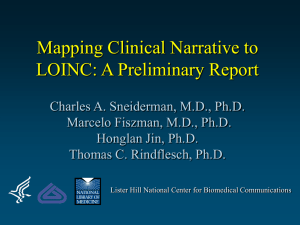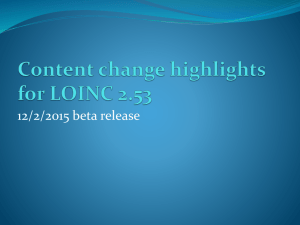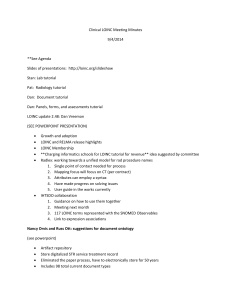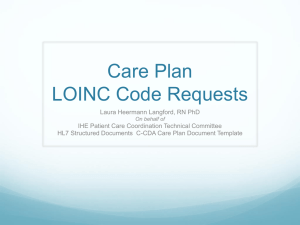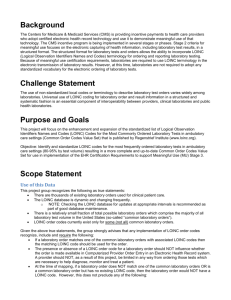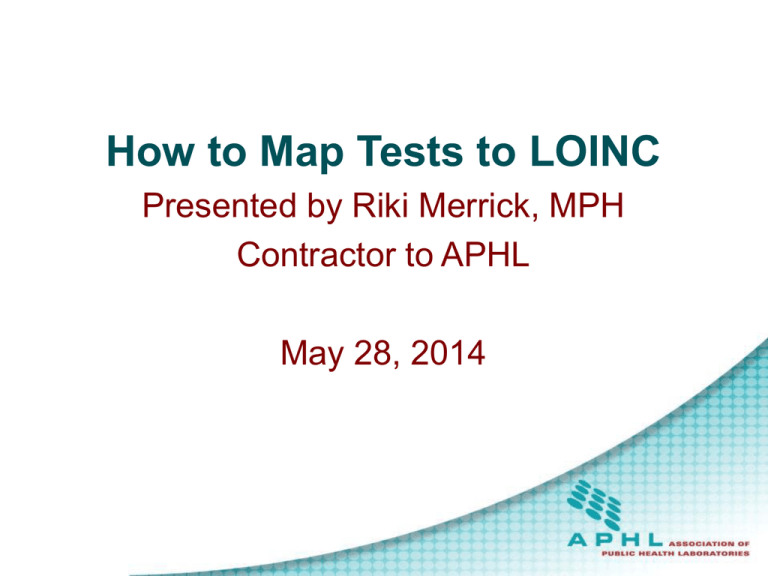
How to Map Tests to LOINC
Presented by Riki Merrick, MPH
Contractor to APHL
May 28, 2014
About Me…
• Contractor to Association of Public Health Laboratories
(APHL)
• Lead Terminologist for the APHL Informatics Program
• Author of ELR Release 2
• Member of HL7 PHER Workgroup and Orders and
Observation Workgroup
• IHE Lab Committee Planning Chair
• Author of NIST 2014 Test Tools for Certification
• Background: licensed physician in Germany
Examples of “Tests” and
“Orders” in context of ELR
Examples of “Tests” and
“Orders” in context of ELR
Examples of “Tests” and
“Orders” in context of ELR
In the HL7 message Structure, Tests and Results
are analogous to Question and Answer pairs
This field
(OBR.4) is for order
This field (OBX.3) is
for observable test.
This field (OBX.5) is
for the result.
Example Pilot message for Long Beach
Public Health Lab(coded vocabulary in red)
•
•
•
•
•
•
•
MSH|^~\&|ApolloLIMS^ApolloOID^ISO|Long Beach Public Health
Laboratory^05D0688088^CLIA|CalREDIE^2.16.840.1.113883.3.33.4.2.2^ISO|CDPH^2.16.840.1.113883
.3.33.4.10.100^ISO|201402211657050800||ORU^R01^ORU_R01|53|T|2.5.1|||NE|NE|||||USELR1.0^^2.16.840.1.114222.4.10.3^ISO|
SFT|Common Cents Systems^L^^^^ApolloLIMS&ApolloOID&ISO^XX^^^|7.0.2.7|ApolloLIMS|binary ID
unknown||20131201
PID|1||318521^^^Long Beach Public Health
Laboratory^2.16.840.1.114222.4.1.24616&ISO^AN||TEST^APOLLO^^^^^||19880915|M||21063^White^CDCREC^W^WHITE^L|2456 DAISY AVENUE^^LONG BEACH^CA^90806^^|||||||||||2186-5^Not
Hispanic or Latino^CDCREC^N^Non-Hispanic^L^2.5.1|||||||||||||
ORC|RE|^Long Beach PHL Test Account^^ISO|Z000672^Long Beach Public Health
Laboratory^2.16.840.1.114222.4.1.24616^ISO||||||20140130|RAW||^Test^Maurice^^^Dr.^MD^^NPI&2
.16.840.1.113883.4.6&ISO^L^^^NPI^^^^^^^^MD||^WPN^PH^^^615^8347666|||||||Long Beach PHL Test
Account^^^^^^^^^|2525 Grand Avenue^^Long Beach^CA^90815|^WPN^PH^^^615^1118888|4701
Trousdale Lane^^Nashville^TN^37167^^^^|||||||
OBR|1|35^^^ISO|Z000672^Long Beach Public Health
Laboratory^2.16.840.1.114222.4.1.24616^ISO|43304-5^Chlamydia trachomatis rRNA [Presence] in
Unspecified specimen by Probe and target amplification method^LN^1020^CHLAMYDIA TRACHOMATIS
rRNA^L|||201401301755450800|||||||||^Test^Maurice^^^Dr.^MD^^NPI&2.16.840.1.113883.4.6&ISO^L^^^NPI^^^^^^^^MD|^WPN^P
H^^^615^1118888|||||20140216152406-0800|||C||||||||||
OBX|1|CWE|43304-5^Chlamydia trachomatis rRNA [Presence] in Unspecified specimen by Probe
and target amplification method^LN^1020^CHLAMYDIA TRACHOMATIS
rRNA^L|1|10828004^Positive^SCT^POS^POSITIVE^L|^^^^^L|||||C|||||^^^^^^^^&&ISO|||201402161524
06-0800
SPM|1|^Z000672&ApolloLIMS&ApolloOID&ISO||437921000124103^First void urine
specimen^SCT^UV^Urine, voided^L^^^Urine, voided|||^^^UV^STERILE CONTAINER^L^^^STERILE
CONTAINER||||||||||||||||||
Generic vs Specific tests
• Sometimes the Question is very specific and
the answer is generic…
Example
Question: Hepatitis B virus core Ab [Presence] in Serum
Answer: Reactive
• or vice versa…
Example
Question: Bacteria identified in Stool by Culture
Answer: Salmonella enterica ss enterica
Resources: Vocabulary
• PHINVADS/RCMT:
https://phinvads.cdc.gov/vads/SearchVocab.action
• LOINC
o Online Search: http://search.loinc.org/
o Download “Relma”: http://loinc.org/
LOINC & SNOMED
So how do you do it?
What is LOINC ?
Logical Observation Identifier Names and Codes
(LOINC):
o Standard names & codes set that identifies
laboratory and clinical observations
o Established in 1994 by Clement McDonald at the
Regenstrief Institute
o More information is available at:
www.regenstrief.org/medinformatics/loinc
What is LOINC used for?
Logical Observation Identifier Names
LOINC is the Question:
What test would you like us to
perform?
What test was performed?
Ask at order Entry Question
In HL7 speak: OBR-4 and OBX-3
Anatomy of a LOINC code
20955-1
• Shortname: Salmonella Stl Cult
• Long Common Name:Salmonella sp identified
in Stool by Organism specific culture
• LOINC parts:
1.
2.
3.
4.
5.
6.
COMPONENT:
SCALE:
PROPERTY:
TIMING:
SAMPLE:
METHOD:
Salmonella Sp Identified
Nom
Prid
Pt
Stl
Organism Specific Culture
http://loinc.org/slideshows
COMPONENT
What am I looking for?
o Bacteria, Virus, Fungus
o Genus specific, i.e. Influenza Virus
o Species specific, i.e. Salmonella enteriditis
o Part of the organism like AG, or RNA / DNA
o Ab against an organism (species or genus
level)
• IgG, IgM, Total
Property
What exactly is being measured?
Knowing the results (including units) is paramount
here!
o QN scale – Mass, concentration, catalytic activity, ratio,
count, volume, length, Titer, rate
o ORD scale – is often assigned an arbitrary property
(most often , Threshold, ACNC)
o NOM scale – for micro is PRID = Presence or Identity
otherwise can be finding, appearance etc
Scale
What format are my results in?
Knowing the results is paramount here!
o Quantitative QN – numeric values (mass, distance,
concentration, volume, titers, ranges)
o Ordinal ORD – list of terms with some order, but without
scale (pos/neg, 1+,2+,3+)
o Nominal NOM – list of names without order (organism
names, categories) Narrative – descriptive text
o Narrative NAR – descriptions (pathology result)
o MULTI – textglob with different result types together as
one observation
Timing
• What timeframe will my information cover?
o PT – Point in time – most common in micro
o Measured over a time period where different
abbreviations are used depending on the time
elapsed – most common would be 24 hours or
12 hours – this affects the property designation
of a rate
System
• What type of specimen was examined?
o This refers to the actual tested form of the specimen - If
more than one specimen type is tested, use XXX –
transmitted elsewhere in the message
(Note XXX = “Unspecified Specimen” in the long
common name description.)
o If test is only performed on Isolates, then use ISLT
o For serology, if it is always either serum or plasma use
Ser or Ser/Plas
Method
• What method was used?
o This is defined to a certain level, for example
PCR is only expressed as target amplified probe
(includes TMA, PCR, LCR, SDA)
o More detail of the method can be sent in
another part of the HL7 message
o Can use “methodless” codes in LOINC too
o Some Common ones include, EIA, PCR,IF,IB,
Culture, Organism Specific Culture,
100 labs working separately
could all correctly code
their local tests using
LOINC and SNOMED, and
yet the process could
generate 100 different
electronic messages for
the same tests.
The Three
Pieces To PHLIP
Harmonization of
Vocabulary and
Messaging Guides.
Implementation of
Production Level
Messages.
Building Collaboration
and Cross Project
Fertilization.
APHL approach to mapping
• Step 1 - Collect information about test
o Local code and description
o First and foremost: really helpful to know what the
possible results will be.
o Know as many of the following 6 properties of the
test in order of importance ( can usually map with
only the first two)
1. component - analyte/What is being observed?
2. Scale
– Qualitative results is “Ord”
– Numeric is “Qn” or “TItr”
– Name of Organism is “Nom”
APHL approach to mapping
• LOINC properties( contin)
3. “Property”
– think units for numeric results
- For qualitative results is either “ACNC” or“Threshold”
- For nominal results is usually “PRID” or “ID”
4. For Specimen can look for the XXX codes
– Or common specimen types Ser, Stool
5. Method can look for the methodless codes
– Some common ones include:
» “EIA”
» “IF” for DFA and IFA
» “Probe.amp.tar” for NAATs
» “Culture”
6. Time is essentially always “PT”
APHL approach to mapping Simplifications
• “XXX” or “unspecified specimen” LOINCs
Why? – Specimen is identified in another
field in the HL7 message
APHL approach to mapping Simplifications
• Cultures are mapped to a generic culture
LOINCs unless they are “Organism Specific”
Why? The result is specific
APHL approach to mapping Simplifications
• “methodless” LOINCs
Why? – When method is unknown from
input
Test Metadata Collection Sheet
Influenza Encoding Guidelines
Process For Consistent Reporting
•
Any PH Lab SME who develops new test
•
Contact PHLIP Vocab Team
•
Engage other programs: LIMSi, CSTE/ELR, etc
•
Resolve language issues (e.g. CAP guidelines)
•
Assign proper LOINC and SNOMED codes
•
Include codes in package insert submission to FDA
•
Quality control submits package insert to FDA
•
Publish codes via APHL Sharepoint and PHINVADS
Resources for Finding the Right
LOINC for ELR
o Use Online LOINC for getting codes :
http://search.loinc.org/
Resources for Finding the Right
LOINC for ELR
• Can download Relma too to use locally: http://loinc.org/
Resources for Finding the Right
LOINC for ELR
• Can download the LOINC Database and query directly from that too to
use locally: http://loinc.org/
Resources for Finding the Right
LOINC for ELR
• Reportable Condition Mapping Tables (RCMT)
http://phinvads.cdc.gov/vads/SearchHome.action
Resources for Finding the Right
LOINC for ELR
• Drafted Common Condition-based LOINC and SNOMED
Encoding Guidance for Public Health and “coding tree
diagrams ” for common reportable tests.
Resources for Finding the Right
LOINC for ELR
Resources for Finding the Right
LOINC for ELR
GC/CT Combination LOINC: 64017-7^Chlamydia trachomatis and Neisseria gonorrhoeae rRNA panel in Unspecified
specimen by Probe and target amplification method
Component: GC LIONC: 43305-2^Neisseria gonorrhoeae rRNA [Presence] in
Unspecified specimen by Probe and target amplification method
Component: CT LOINC:43304-5^Chlamydia trachomatis rRNA
[Presence] in Unspecified specimen by Probe and target amplification
method
Positive SNOMED Code
10828004^Positive(qualifier value)
Positive SNOMED Code
10828004^Positive(qualifier value)
Negative SNOMED Code
260385009^Negative(qualifier value)
Negative SNOMED Code
260385009^Negative(qualifier value)
Other(Inconclusive, etc)
Other(Inconclusive, etc)
LOINC Copyright Notice
"This product includes all or a portion of the LOINC® database, or is derived from
the LOINC® database, subject to a license from Regenstrief Institute, Inc. Your
use of the LOINC database and LOINC codes also is subject to this license, a
copy of which is available at http://www.regenstrief.org/loinc/#copyright. The
current complete LOINC database and Users' Guide are available for download
at http://www.regenstrief.org/loinc. The LOINC database and LOINC codes are
copyright (c) 1995-2013, Regenstrief Institute, Inc. and the Logical Observation
Identifiers Names and Codes (LOINC) Committee. All rights reserved. THE
LOINC DATABASE IS PROVIDED "AS IS." ANY EXPRESS OR IMPLIED
WARRANTIES ARE DISCLAIMED, INCLUDING, BUT NOT LIMITED TO, THE IMPLIED
WARRANTIES OF MERCHANTABILITY AND FITNESS FOR A PARTICULAR
PURPOSE. LOINC® is a registered United States trademark of Regenstrief
Institute, Inc. A small portion of the LOINC table may include content (e.g.,
survey instruments) that is subject to copyrights owned by third parties. Such
content has been mapped to LOINC terms under applicable copyright and terms
of use. Notice of such third party copyright and license terms would need to be
included if such content is included."
Helpful links from loinc.org
• For newbies: http://loinc.org/get-started
• More slide shows:
http://loinc.org/slideshows
• Recommended readings:
http://loinc.org/documentation/recommende
d-readings.html
• FAQs: http://loinc.org/faq
Questions?
Contact me at:
rikimerrick@gmail.com


